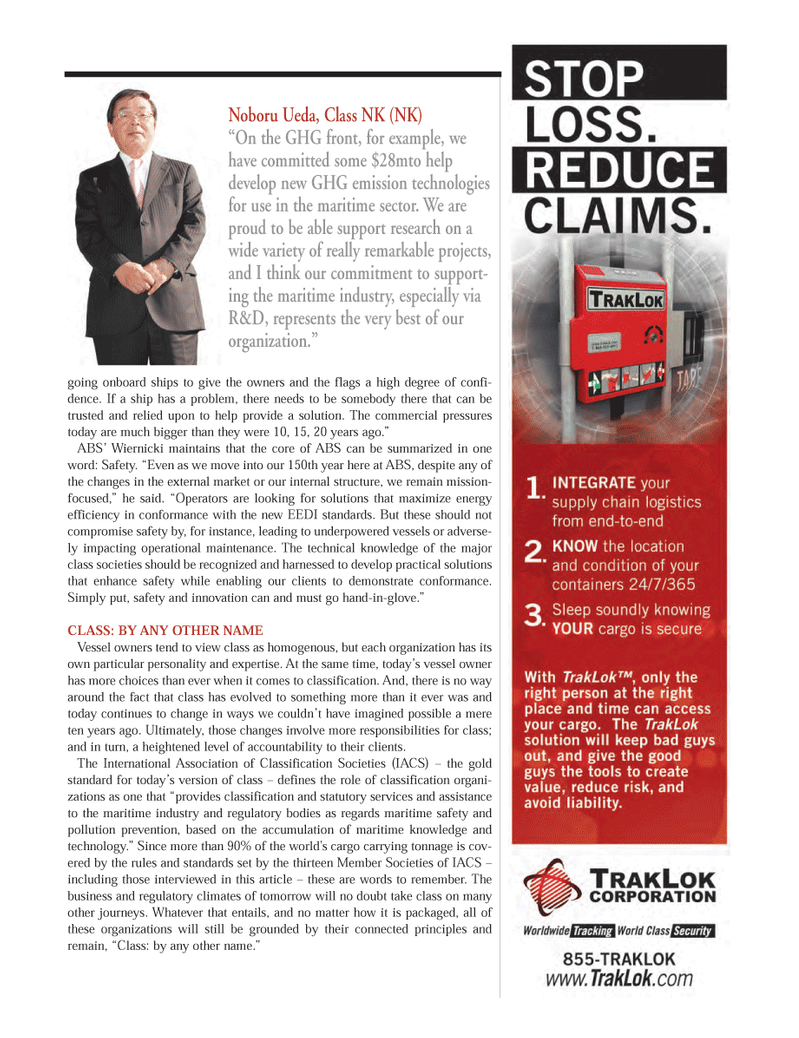
Page 37: of Maritime Logistics Professional Magazine (Q4 2011)
Classification
Read this page in Pdf, Flash or Html5 edition of Q4 2011 Maritime Logistics Professional Magazine
going onboard ships to give the owners and the flags a high degree of confi- dence. If a ship has a problem, there needs to be somebody there that can betrusted and relied upon to help provide a solution. The commercial pressures today are much bigger than they were 10, 15, 20 years ago.? ABS? Wiernicki maintains that the core of ABS can be summarized in one word: Safety. ?Even as we move into our 150th year here at ABS, despite any of the changes in the external market or our internal structure, we remain mission- focused,? he said. ?Operators are looking for solutions that maximize energy efficiency in conformance with the new EEDI standards. But these should not compromise safety by, for instance, leading to underpowered vessels or adverse- ly impacting operational maintenance. The technical knowledge of the major class societies should be recognized and harnessed to develop practical solutions that enhance safety while enabling our clients to demonstrate conformance.Simply put, safety and innovation can and must go hand-in-glove.? CLASS: BY ANY OTHER NAME Vessel owners tend to view class as homogenous, but each organization has its own particular personality and expertise. At the same time, today?s vessel owner has more choices than ever when it comes to classification. And, there is no way around the fact that class has evolved to something more than it ever was and today continues to change in ways we couldn?t have imagined possible a mere ten years ago. Ultimately, those changes involve more responsibilities for class; and in turn, a heightened level of accountability to their clients. The International Association of Classification Societies (IACS) ? the gold standard for today?s version of class ? defines the role of classification organi- zations as one that ?provides classification and statutory services and assistance to the maritime industry and regulatory bodies as regards maritime safety and pollution prevention, based on the accumulation of maritime knowledge and technology.? Since more than 90% of the world's cargo carrying tonnage is cov- ered by the rules and standards set by the thirteen Member Societies of IACS ? including those interviewed in this article ? these are words to remember. The business and regulatory climates of tomorrow will no doubt take class on many other journeys. Whatever that entails, and no matter how it is packaged, all of these organizations will still be grounded by their connected principles and remain, ?Class: by any other name.? Noboru Ueda, Class NK (NK) ?On the GHG front, for example, we have committed some $28mto help develop new GHG emission technologies for use in the maritime sector. We are proud to be able support research on a wide variety of really remarkable projects, and I think our commitment to support- ing the maritime industry, especially via R&D, represents the very best of our organization.?MP #4 (34-49):MP Layouts 11/8/2011 2:00 PM Page 37

 36
36

 38
38
